We have much more to do and your continued support is needed now more than ever.
Mission Desert Tortoise

And these critters are worth the effort. Desert tortoises are simply remarkable animals and have existed unchanged for about 18 million years. As a Californian, I am proud of our intrepid little Mojave desert tortoise (Gopherus agassizii) who manages to survive in the driest desert in North America. They dig burrows that stretch for over twenty feet and can hand them down to multiple generations. Their bladder allows them to store up to 40% of their body weight in water in order to access it during the dry season. Since the Mojave receives only 5 inches of rain a year, and mostly in the winter season, this storage capacity is a vital adaptation for survival.

Next stop: Mojave National Preserve. The scenery alone made the drive through the preserve worth the trip, and the surrounding mountains, twisted Joshua Tree woodlands, serene desert dunes, and scrub bush lowlands combined to create a magnificent symphony of nature. When we arrived at the Nipton Hotel for the night (great place to stay when visiting the Mojave), I gazed across the Ivanpah Valley and thought how much it resembled a seascape. The dark lowlands gave the impression of the ocean surface in motion, perhaps the desert’s memory of its once watery origins. Alas, we saw no desert tortoises again that day, but as we sipped wine and gazed at the stars, we both agreed it didn’t matter (well, maybe it mattered a little).
Our final chance (at least for this trip) was at Red Rock Canyon National Conservation Area. When we first arrived at the viewing area at the Red Rock Canyon Visitor Center, much to our dismay none of the tortoises had emerged from their burrows. So instead we wandered into the Mojave Max education area. Mojave Max is the official spokestortoise for the Clark County Desert Conservation Program. We also toured the exhibits at the center—and I rate it one of the best visitor centers I have experienced—really fun and well designed.
[youtube]http://www.youtube.com/watch?v=Cjf3eAnsFgs[/youtube]

Desert tortoises are to be celebrated, as they are just cool critters. Yet they are also threatened animals. Both the California and the Federal Endangered Species Acts list the Mojave population as threatened, the result of habitat loss and fragmentation, disease, over-predation, human poaching, and invasive species. Renewable energy siting issues have the potential to impact the future of the tortoise. Climate change—combined with the other challenges—also poses a grave threat for this animal, as the increased temperatures may render an already extreme habitat uninhabitable and push the animal to extinction.
How can you help? You can symbolically adopt a desert tortoise through the National Wildlife Federation or donate to help support our important work in wildlife conservation.
But most importantly, your mission—should you choose to accept it—is to embark on your own fun search to see a desert tortoise.























